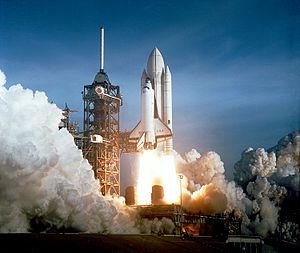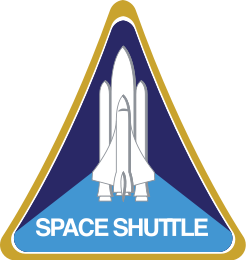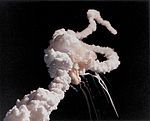
Space Shuttle program
Background to the schools Wikipedia
This selection is made for schools by a children's charity read more. SOS mothers each look after a a family of sponsored children.
NASA's Space Shuttle, officially called Space Transportation System (STS), is the United States government's current manned launch vehicle. The winged Shuttle Orbiter is launched vertically, usually carrying five to seven astronauts (although eight have been carried) and up to 50,000 lb (22 700 kg) of payload into low earth orbit. When its mission is complete, the Shuttle can independently move itself out of orbit (by means of its maneuvering thrusters) and re-enter the Earth's atmosphere. During descent and landing, the Shuttle Orbiter acts as a glider and makes a completely unpowered landing.
The Shuttle is the only winged manned spacecraft to achieve orbit and land, and the only reusable space vehicle that has ever made multiple flights into orbit. Its missions involve carrying large payloads to various orbits (including segments to be added to the International Space Station), providing crew rotation for the International Space Station, and performing service missions. The orbiter can also recover satellites and other payloads from orbit and return them to Earth, but its use in this capacity is rare. However, the Shuttle has previously been used to return large payloads from the ISS to Earth, as the Russian Soyuz spacecraft has limited capacity for return payloads. Each vehicle was designed with a projected lifespan of 100 launches, or 10 years' operational life.
The program started in the late 1960s and has dominated NASA's manned operations since the mid-1970s. According to the Vision for Space Exploration, use of the Space Shuttle will be focused on completing assembly of the ISS by 2010, after which it will be retired from service, and eventually replaced by the new Orion spacecraft (now expected to be ready in about 2014).
Conception

Even before the Apollo 11 moon landing in 1969, NASA began early studies of space shuttle designs. The early studies beginning in October, 1968 were denoted "Phase A." Further studies resulted in "Phase B" in June 1970. These plans were much more detailed and more specific.
In 1969 President Richard Nixon formed the Space Task Group, chaired by vice president Spiro T. Agnew. This group evaluated the shuttle studies to date, and recommended a national space strategy including building a space shuttle.
In October 1969, at a Space Shuttle symposium held in Washington, George Mueller (NASA's deputy administrator) presented opening remarks:
The goal we have set for ourselves is the reduction of the present costs of operating in space from the current figure of $1,000 a pound for a payload delivered in orbit by the Saturn V, down to a level of somewhere between $20 and $50 a pound. By so doing we can open up a whole new era of space exploration. Therefore, the challenge before this symposium and before all of us in the Air Force and NASA in the weeks and months ahead is to be sure that we can implement a system that is capable of doing just that.
Let me outline three areas which, in my view, are critical to the achievement of these objectives. One is the development of an engine that will provide sufficient specific impulse, with adequate margin to propel its own weight and the desired payload.
A second technical problem is the development of the reentry heat shield, so that we can reuse that heat shield time after time with minimal refurbishment and testing.
The third general critical development area is a checkout and control system which provides autonomous operation by the crew without major support from the ground and which will allow low cost of maintenance and repair. Of the three, the latter may be a greater challenge than the first two.
The 1972 NASA/GAO REPORT TO THE CONGRESS, Cost-Benefit Analysis Used In Support Of The Space Shuttle Program states:
NASA has proposed that a space shuttle be developed for U.S. Space Transportation needs for NASA, the Department of Defense (DOD), and other users in the 1980s.The primary objective of the Space Shuttle Program is to provide a new space transportation capability that will:
- reduce substantially the cost of space operations and
- provide a future capability designed to support a wide range of scientific, defense, and commercial uses.
Development
During early shuttle development there was great debate about the optimal shuttle design that best balanced capability, development cost and operating cost. Ultimately the current design was chosen, using a reusable winged orbiter, solid rocket boosters, and an expendable external tank.
The Space Shuttle program was formally launched on January 5, 1972, when President Nixon announced that NASA would proceed with the development of a reusable Space Shuttle system. The final design was less costly to build and less technically ambitious than earlier fully reusable designs. The initial design parameters included a larger external fuel tank, which would have been carried to orbit, where it could be used as a section of a space station, but this idea was killed due to budgetary and political considerations.
The prime contractor for the program was North American Aviation (later Rockwell International, now Boeing), the same company responsible for building the Apollo Command/Service Module. The contractor for the Space Shuttle Solid Rocket Boosters was Morton Thiokol (now part of Alliant Techsystems), for the external tank, Martin Marietta (now Lockheed Martin), and for the Space shuttle main engines, Rocketdyne (now Pratt & Whitney Rocketdyne, part of United Technologies).
The first complete orbiter was originally planned to be named Constitution, but a massive write-in campaign from fans of the Star Trek television series convinced the White House to change the name to Enterprise. Amid great fanfare, the Enterprise was rolled out on September 17, 1976, and later conducted a successful series of glide-approach and landing tests that were the first real validation of the design.
The first fully functional Shuttle Orbiter was the Columbia, built in Palmdale, California. It was delivered to Kennedy Space Centre on March 25, 1979, and was first launched on April 12, 1981—the 20th anniversary of Yuri Gagarin's space flight—with a crew of two. Challenger was delivered to KSC in July 1982, Discovery in November 1983, and Atlantis in April 1985. Challenger was destroyed during ascent due to O-Ring failure on the right SRB on January 28, 1986, with the loss of all seven astronauts on board. Endeavour was built to replace Challenger (using spare parts originally intended for the other orbiters) and delivered in May 1991; it was first launched a year later. Seventeen years after Challenger, Columbia was lost, with all seven crew members, during reentry on February 1, 2003, and has not been replaced. Out of the five fully functional shuttle orbiters built, three remain.
Shuttle applications
Current and past Space Shuttle's applications include:
- Crew rotation and servicing of Mir and the International Space Station (ISS)
- Manned servicing missions, such as to the Hubble Space Telescope (HST)
- Manned experiments in Low Earth orbit (LEO)
- Carried to LEO:
- Large satellites — including the HST
- Components for the construction of the ISS
- Supplies in Spacehab modules or Multi-Purpose Logistics Modules
- Carried satellites with a booster, the Payload Assist Module (PAM-D) or the Inertial Upper Stage (IUS), to the point where the booster sends the satellite to:
- A higher Earth orbit; these have included:
- Chandra X-ray Observatory
- Many TDRS satellites
- Two DSCS-III (Defense Satellite Communications System) communications satellites in one mission
- A Defense Support Program satellite
- An interplanetary orbit; these have included:
- Magellan probe
- Galileo spacecraft
- Ulysses probe
- A higher Earth orbit; these have included:
Flight statistics
| Shuttle | Atmospheric test flights |
Flight days | Longest flight | First flight | Last flight | ||||
|---|---|---|---|---|---|---|---|---|---|
| ALT | Date | ALT | Date | ||||||
| Enterprise | 5 | 00d 00h 19m | 00d 00h 05m | ALT-12 | Aug 12, 1977 | ALT-16 | Oct 26, 1977 | ||
| Shuttle | Flights | Flight days | Orbits | Longest flight | First flight | Last flight | Mir/ISS docking |
||
| STS | Launched | STS | Launched | ||||||
| Columbia † | 28 | 300d 17h 47m 15s | 4,808 | 17d 15h 53m 18s | STS-1 | Apr 12, 1981 | STS-107 † | Jan 16, 2003 | 0 / 0 |
| Challenger † | 10 | 62d 07h 56m 15s | 995 | 08d 05h 23m 33s | STS-6 | Apr 04, 1983 | STS-51-L † | Jan 28, 1986 | 0 / 0 |
| Discovery | 39 | 364d 22h 39m 29s | 5,830 | 15d 02h 48m 08s | STS-41-D | Aug 30, 1984 | STS-133 | Feb 24, 2011 | 1 / 13 |
| Atlantis | 33 | 306d 14h 12m 43s | 4,848 | 13d 20h 12m 44s | STS-51-J | Oct 03, 1985 | STS-135 | July 8, 2011 | 7 / 12 |
| Endeavour | 25 | 296d 03h 34m 02s | 4,677 | 16d 15h 08m 48s | STS-49 | May 07, 1992 | STS-134 | May 16, 2011 | 1 / 12 |
| Total | 135 | 1330d 18h 9m 44s | 21,158 | 9 / 37 | |||||
† Destroyed
Other shuttles
| Shuttle | Flight Days | Orbits | Distance -mi- |
Distance -km- |
Flights | Longest flight -days- |
Crew and passengers |
EVAs | Mir/ISS docking |
Satellites deployed |
|---|---|---|---|---|---|---|---|---|---|---|
| Enterprise | 0.014 | 0 | Unknown | Unknown | 0 | 0.004 | >3 | 0 | 0 / 0 | 0 |
Disasters
As of 2007, two Shuttles have been destroyed in 120 missions, both with the loss of the entire crew (14 astronauts total):
- Challenger — lost 73 seconds after liftoff, STS-51-L, January 28, 1986
- Columbia — lost approximately 16 minutes before its expected landing, STS-107, February 1, 2003
This gives a 2% death rate per astronaut-flight, and an average failure rate of more than 1 every 60 missions. The original disaster potential, though disaster is not defined as fatal or non-fatal, was estimated during Shuttle development at one every 75 missions. 87 successful missions were flown between STS-51-L and STS-107.
Current status
After the Space Shuttle Columbia disaster in 2003, the International Space Station operated on a skeleton crew of two for more than two years and was serviced primarily by Russian spacecraft. While the "Return to Flight" mission STS-114 in 2005 was successful, a similar piece of foam from a different portion of the tank was shed. Although the debris did not strike the orbiter, the program was grounded once again for this reason.
The second "Return to Flight" mission, STS-121, launched on July 4, 2006, at 2:37:55 p.m. (EDT), after two previous launches were scrubbed because of lingering thunderstorms and high winds around the launch pad and the launch took place despite objections from its chief engineer and safety head. A five-inch (13 cm) crack in the foam insulation of the external tank gave cause for concern; however, the Mission Management Team gave the go for launch. This mission increased the ISS crew to three. Discovery touched down successfully on July 17, 2006 at 9:14:43 a.m. (EDT) on Runway 15 at Kennedy Space Centre.
Following the success of STS-121, five missions have been completed without major foam problems, and the construction of ISS has resumed. (During the STS-118 mission in August 2007, the orbiter was again struck by a foam fragment on liftoff, but this was a very small damage compared to the damage sustained to Columbia.)
On October 31, 2006, NASA announced approval of a shuttle servicing mission to the Hubble Space Telescope.
The Shuttle program is scheduled for mandatory retirement in 2010. The Shuttle's planned successor is Project Constellation with its Ares I and Ares V launch vehicles and the Orion Spacecraft. NASA plans to launch 11 to 13 more shuttle missions before the program ceases.
Since 2005, the manager of the Space Shuttle program has been Wayne Hale.
Costs
The total cost of the Shuttle program has been $145 billion as of early 2005 , and is estimated to be $174 billion when the Shuttle retires in 2010. NASA's budget for 2005 allocated 30%, or $5 billion, to Space Shuttle operations; this was decreased in 2006 to a request of $4.3 billion.
Per-launch costs can be measured by dividing the total cost over the life of the program (including buildings, facilities, training, salaries, etc) by the number of launches. With 115 missions (as of 6 August 2006), and a total cost of $150 billion ($145 billion as of early 2005 + $5 billion for 2005, this gives approximately $1.3 billion per launch. Another method is to calculate the incremental (or marginal) cost differential to add or subtract one flight — just the immediate resources expended/saved/involved in that one flight. This is about $60 million.
Early cost estimates of $118 per pound ($260/kg) of payload were based on marginal or incremental launch costs, and based on 1972 dollars and assuming a 65,000 pound (30 000 kg) payload capacity. Correcting for inflation, this equates to roughly $36 million incremental per launch costs. Compared to this, today's actual incremental per launch costs are about two thirds more, or $60 million per launch.
Criticism
The Space Shuttle program has been criticized for failing to achieve its promised cost and utility goals, as well as design, cost, management, and safety issues.
After both the Challenger disaster and the Columbia disaster, high profile boards convened to investigate the accidents with both committees returning praise and serious critiques to the program and NASA management. One of the most famous of these criticisms came from Nobel Prize winner Richard Feynman.
Terrestrial transportation vehicles
- The Crawler-Transporter carries the Mobile Launcher Platform and the Space Shuttle from the Vehicle Assembly Building to Launch Complex 39.
- The Shuttle Carrier Aircraft are two modified Boeing 747s. Either can fly an orbiter from alternative landing sites back to Cape Canaveral.
- A 36-wheeled transport trailer, the Orbiter Transfer System, originally built for the U.S. Air Force's launch facility at Vandenberg Air Force Base in California (since then converted for Delta IV rockets) that would transport the orbiter from the landing facility to the launch pad, which allowed both "stacking" and launch without utilizing a separate VAB-style building and crawler-transporter roadway. Prior to the closing of the Vandenberg facility, orbiters were transported from the OPF to the VAB on its undercarriage, only to be raised when the orbiter was being lifted for attachment to the SRB/ET stack. The trailer allows the transportation of the orbiter from the OPF to either the SCA-747 "Mate-Demate" stand or the VAB without placing any additional stress on the undercarriage.
- The Crew Transport Vehicle (CTV), a modified airport "People Mover", is used to assist astronauts to egress from the orbiter after landing. Upon entering the CTV, astronauts can take off their launch and re-entry suits then proceed to chairs and beds for medical checks before being transported back to the crew quarters in the Operations and Checkout Building.
- The AstroVan is used to transport astronauts from the crew quarters in the Operations and Checkout Building to the launch pad on launch day. It is also used to transport astronauts back again from the Crew Transport Vehicle at the Shuttle Landing Facility.


